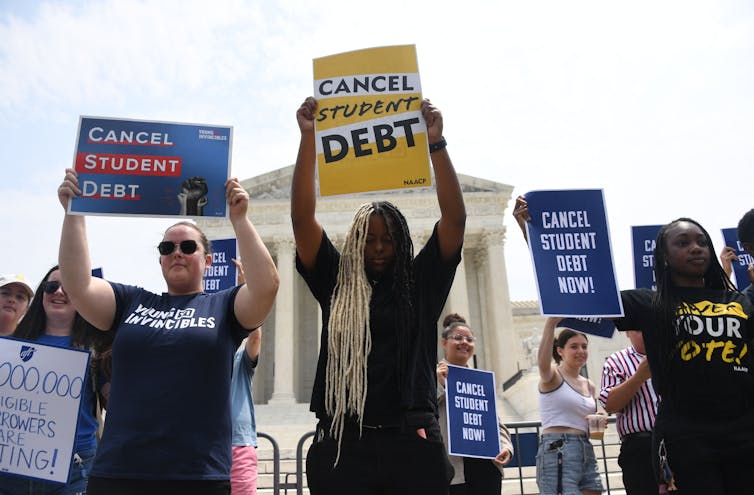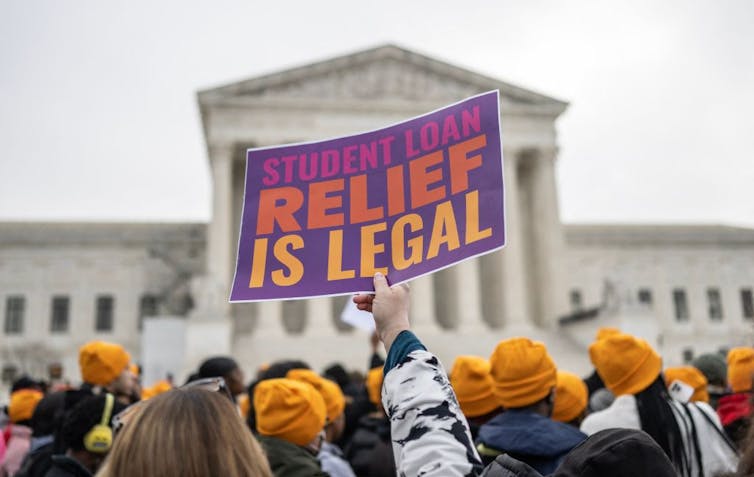Now that President Biden’s student loan cancellation program has been canceled, here’s what’s next

The Supreme Court has struck down the Biden administration’s student loan forgiveness plan. In Biden v. Nebraska, the court ruled 6-3 on June 30, 2023, that the secretary of education does not have the authority to forgive US$430 billion of student loans under the Health and Economic Recovery Omnibus Emergency Solutions Act.
That kills the president’s proposed plan to forgive up to $10,000 in student loans per borrower for those with incomes under $125,000 per year, or $250,000 per year for couples. Under the president’s plan, those who received Pell Grants would have been eligible to cancel up to an additional $10,000 in student loans.
Just hours after the decision, President Biden announced a new effort to forgive student loans under the Higher Education Act of 1965.
To give borrowers time to “get back up and running,” Biden stated that the Education Department won’t refer borrowers who don’t pay their student loan bills to credit agencies for 12 months.
Secretary lacks authority
In the majority opinion, Chief Justice John Roberts – joined by his five other conservative colleagues – stated “The HEROES Act allows the Secretary to ‘waive or modify’ existing … financial assistance programs under the Education Act, but does not allow the Secretary to rewrite that statute to the extent of canceling $430 billion of student loan principal.”
Currently, over 43 million Americans owe $1.64 trillion in federal student loans, with an average balance of $46,000. Student loan borrowers haven’t had to make payments on their federal loans – or accrue interest on those loans – since March 2020, when the Trump administration put the payments on pause due to the COVID-19 pandemic.

But that will change on Sept. 1, 2023, when interest will once again begin to accrue on outstanding student loans. Payments on the actual loans is set to resume in October 2023.
When payments resume, the average student loan payment is expected to be between $200 and $500 per month. For those that resume making their federal student loan payments on time, this may lead to an increase in their credit score, while those that miss the first payment after payments resume can expect their credit score to fall.
Prior to the student loan pause, approximately 7.5 million borrowers – out of 43 million – were in default on their federal student loans.
These borrowers can apply for the Fresh Start program. For borrowers who are behind on their federal student loan payments, this program allows student loan borrowers to reset their loan so they won’t be considered past due anymore.
In addition, any negative entries on their credit report due to being behind on their student loans will be removed. About 80% of Fresh Start borrowers enroll in an income-driven repayment plan. Such a plan calculates a borrower’s monthly federal student loan payment based on the borrower’s income, spouse’s income and family size. Monthly payments under this plan will not exceed 20% of the borrower’s income. Those with larger families and lower incomes have lower monthly payments. Currently, about half of the Fresh Start borrowers pay $0 a month.
It is estimated that student loan borrowers pay about $70 billion a year on their federal student loans. Any economic benefit that borrowers may have gotten from the suspension of student loan payments is likely to have already been absorbed into the economy over the past three years. In other words, any money borrowers had to spend as a result of the student loan pause has already been spent.
With the resumption of student loan payments, there will likely be a small but negative impact on the economy. This reduction in spending on goods and services is estimated to reduce economic growth by about 0.4%
When student loan borrowers begin to repay their loans in October, those dollars will no longer be available to pay for other things like food, rent, clothing or gas. So it won’t only hurt the economy, but it will hurt people, too.![]()
This article is republished from The Conversation under a Creative Commons license. Read the original article.
About The Conversation
The Conversation (https://theconversation.com/us) is an independent, nonprofit publisher of commentary and analysis, authored by academics and edited by journalists for the general public. The Conversation publishes short articles (800-1000 words) by academics on timely topics related to their research.
Share this article
For more information, contact University Communications:Jayme Blaschke, 512-245-2555 Sandy Pantlik, 512-245-2922 |